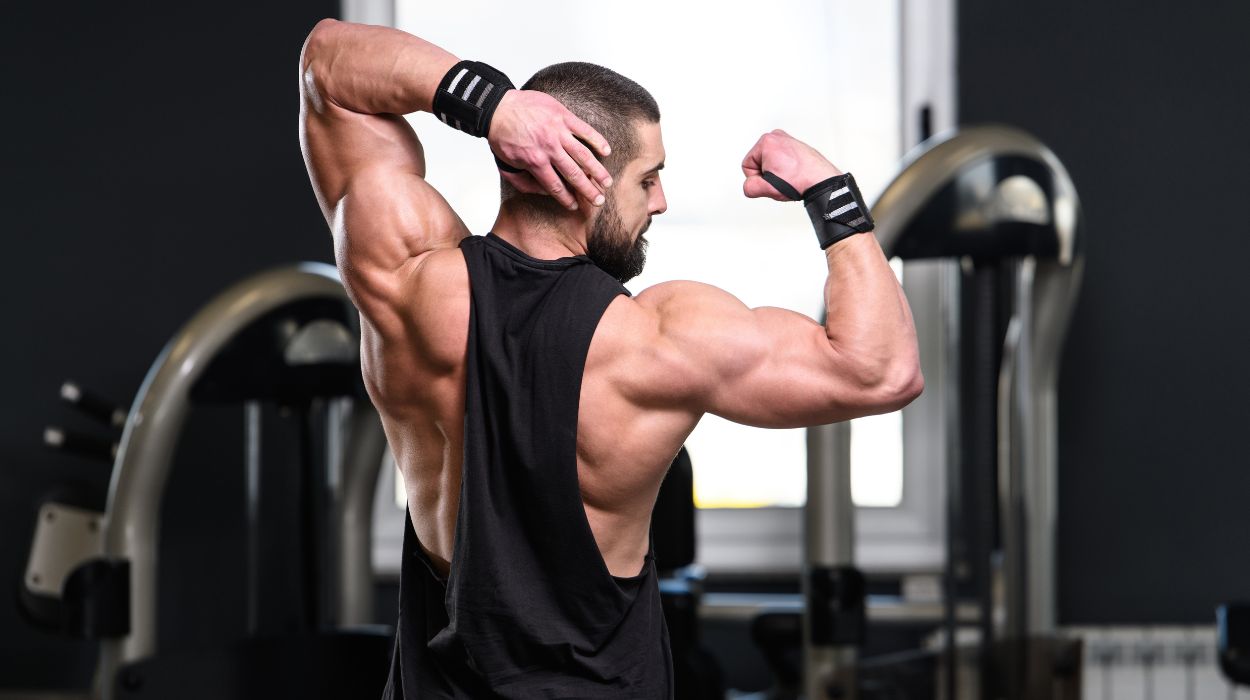
Have you spent months or years trying to build your biceps, only to feel like you just never quite make it to your goal? It is quite possible that what you have been missing all along is simply including workouts in your routine that work the long head of the biceps.[1]
This is the outer part of the biceps that creates a peak shape from the back when you do a bicep pose. The muscle connects to the upper arm and shoulder, and, when exercised correctly, can provide the chiseled finishing touches on your biceps, which is why we have included five incredible long head bicep exercises that will help you achieve those results.
Best Long Head Bicep Exercises
- Incline Dumbbell Curl
- Hammer Curl
- Close Grip Barbell Curl
- Drag Curl
- Close Grip Cable Curl
- Single Arm Cable Curl
Best Long Head Bicep Exercises For 2024
We have included six of the best long-head bicep exercises below with step-by-step guides.
Incline Dumbbell Curl
For this exercise, you will need to lay on an inclined bench of around 30-45 degrees with a pair of dumbbells in your hands.
The upper arm position would be behind the trunk of the body while curling, placing the biceps brachii in a stretched position. For this reason, it is activated to a greater extent, while reducing the involvement of the short head.
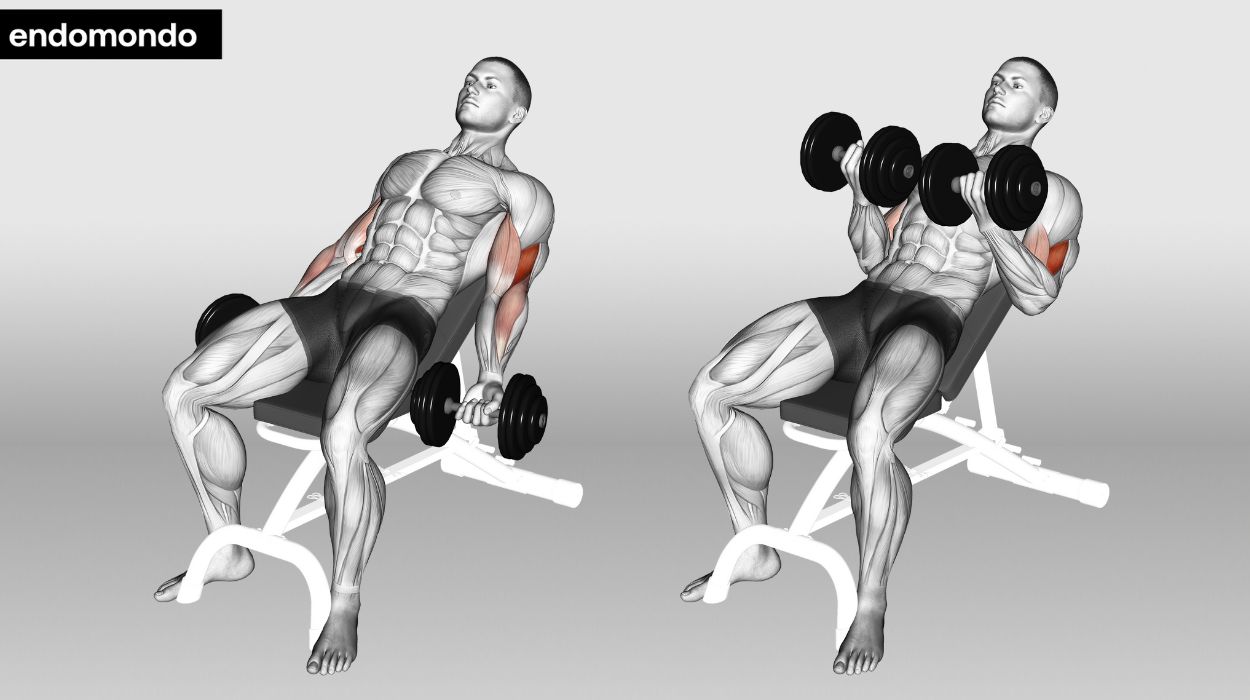
How to do:
- Adjust the incline of an exercise bench to ~45 degrees.
- Grasp a pair of dumbbells with the palms facing up and lay back on an exercise bench.
- Keep your feet flat on the floor and shoulder-width apart to stabilize your body weight.
- Take a deep breath, keep the upper arm stable, and curl the lower arm up towards the shoulders.
- Squeeze the biceps at the top of the movement, breathe out, and then slowly lower them back to the starting position.
- Repeat the movement.
Tips:
- Set the incline bench to a comfortable angle to isolate the biceps effectively while reducing shoulder strain.
- Keep your elbows stationary and close to your sides throughout the movement to maximize biceps activation and minimize swinging.
- Use a controlled tempo, focusing on squeezing the biceps at the top of the curl and lowering the weights slowly to maximize muscle engagement and time under tension.
Optimal Sets and Reps: 4 sets of 8-12 reps.
Hammer Curl
The hammer curl is a bicep curl with a hammer grip. This exercise primarily works the brachioradialis but is listed among the long-head biceps exercises, as it does indeed involve those muscles.
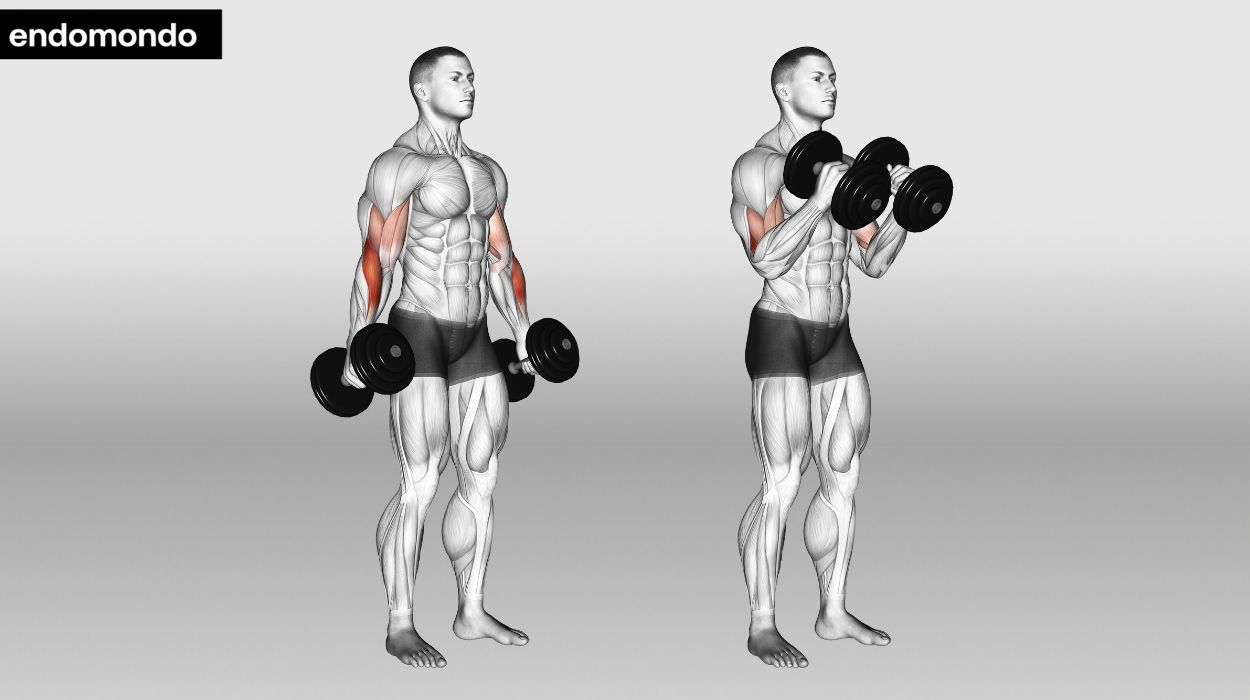
How to do:
- Stand upright with the feet hip-width apart, brace the core, and grasp a pair of suitable dumbbells.
- Turn the hands inwards into a hammer-like position.
- Keep the upper arm and shoulder joint stable, breathe in, and begin to curl the dumbbells up.
- Breathe out and lower the dumbbells.
- Repeat the movement for the intended rep range.
Tips:
- Maintain a neutral grip throughout the movement, keeping your palms facing each other, to target both the biceps and brachialis muscles effectively.
- Keep your elbows close to your sides and avoid swinging or using momentum to lift the weights, ensuring proper isolation of the target muscles.
- Control the weights on the way up and down, focusing on a slow and controlled tempo to maximize muscle engagement and prevent injury.
Optimal Sets and Reps: 4 sets of 10-12 reps.
Close Grip Barbell Curl
Barbell curls with a closer grip stretch the long head of the biceps muscle, therefore activating them more than the short head. Possibly one of the simplest and arguably the most effective upper-body bicep exercises.
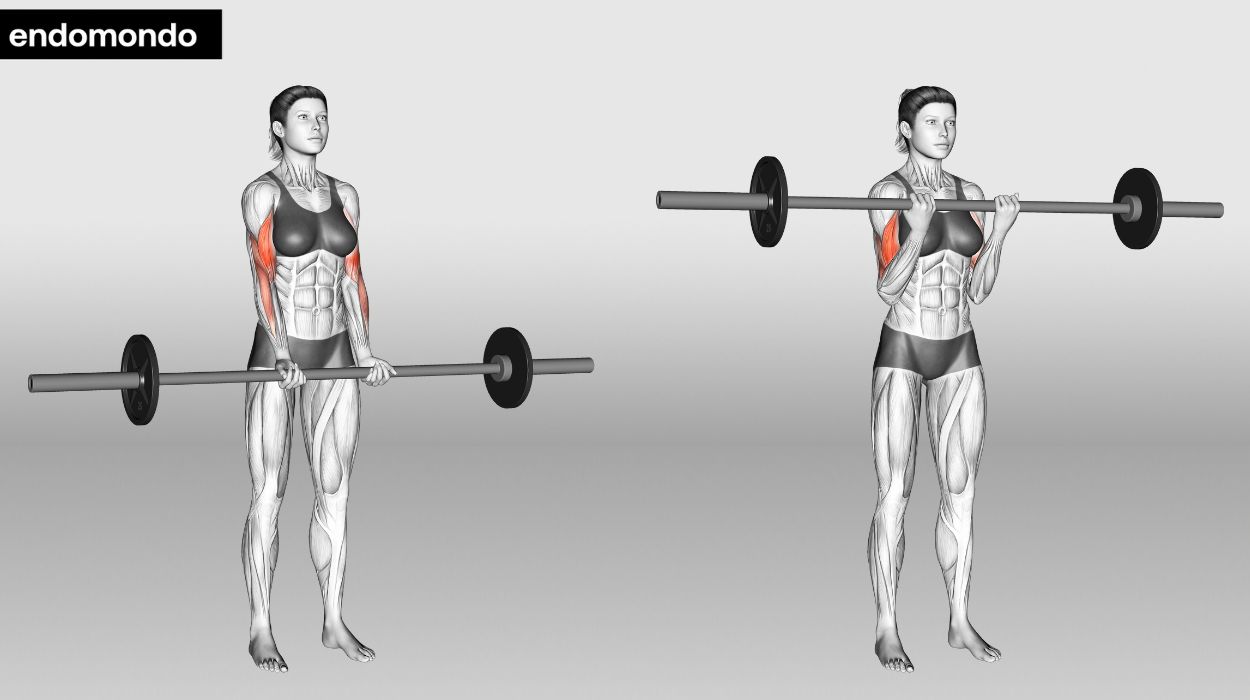
How to do:
- Load up a barbell and stand in the center close to the knurling of the bar.
- Grasp the barbell with an underhand grip closer than hip-width apart.
- Stand upright with feet hip/shoulder width apart.
- Keep the upper arm and shoulder joint stable, breathe in, and begin to curl the barbell up.
- Breathe out and lower the barbell.
- Repeat the movement for the intended rep range.
Tips:
- Maintain a grip slightly narrower than shoulder-width apart to target the inner portion of the biceps effectively.
- Keep your elbows close to your sides throughout the movement to maximize biceps activation and minimize swinging.
- Control the movement, focusing on a slow and deliberate tempo, to ensure proper muscle engagement and prevent momentum from taking over.
Optimal Sets and Reps: 4 sets of 8-12 reps.
Drag Curl
With the drag curl, you hold a barbell with an underhand grip and the shoulders/upper arms are pulled behind the trunk of the body to the point where the long head of the biceps is stretched and put in a position to increase the activity.
Curling the lower arm from this type of position puts extra emphasis on the long head while reducing the involvement of the short head.
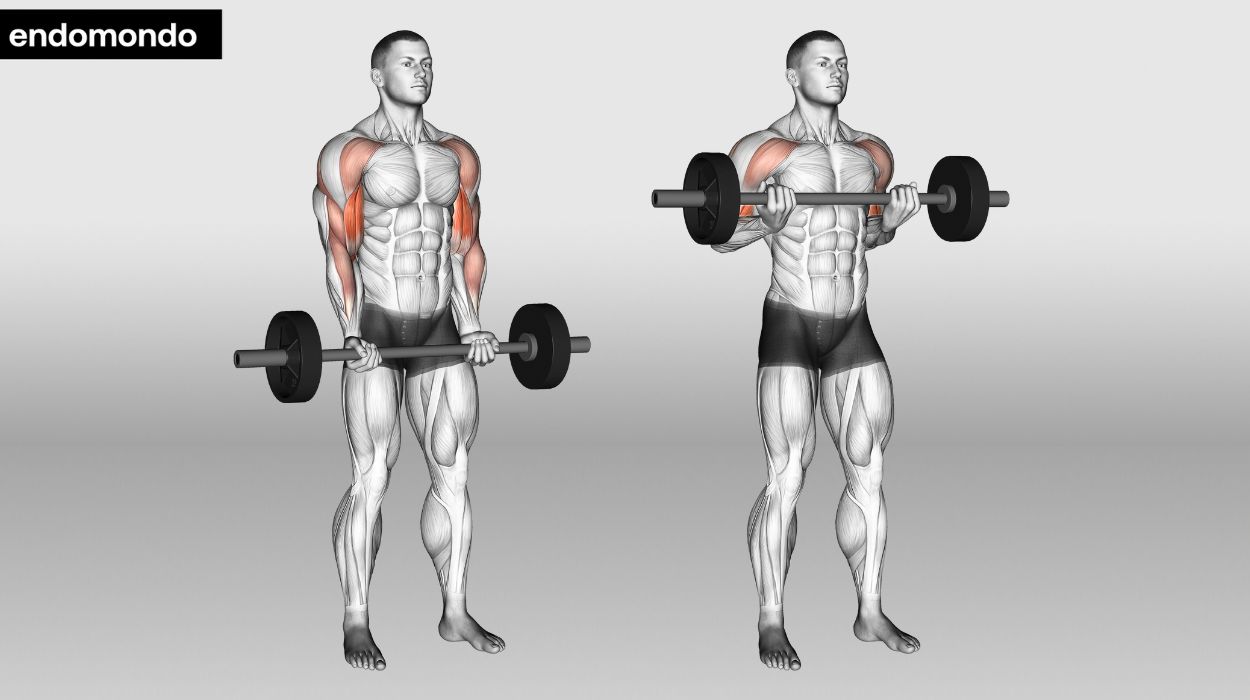
How to do:
- Load up a barbell and stand in the center close to the knurling.
- Grasp the barbell with an underhand grip around hip-width apart.
- Stand up and upright with the feet hip/shoulder width apart.
- Keep the upper arm and shoulder joint stable pull behind the trunk of the body, breathe in, and begin to drag the barbell up the hips and body.
- Breathe out and lower the barbell.
- Repeat the movement for the intended rep range.
Tips:
- Keep your elbows behind your torso throughout the movement to emphasize biceps activation and reduce shoulder involvement.
- Focus on pulling the barbell up towards your upper chest while keeping it in contact with your body to maximize the contraction in your biceps.
- Control the eccentric (lowering) phase of the movement, ensuring a slow and controlled descent to fully engage the biceps muscles.
Optimal Sets and Reps: 4 sets of 8-12 reps.
Close Grip Cable Curl
The close-grip cable curl is almost identical to the close-grip barbell curl. The only difference is that it may isolate the biceps more as opposed to involving other muscle groups to complete the movements. The movements are similar to the free-weight variant, but the cable motion is fixed so there is less chance of involving the upper arm.
Another benefit of the close grip cable curl is that it is more beginner-friendly.
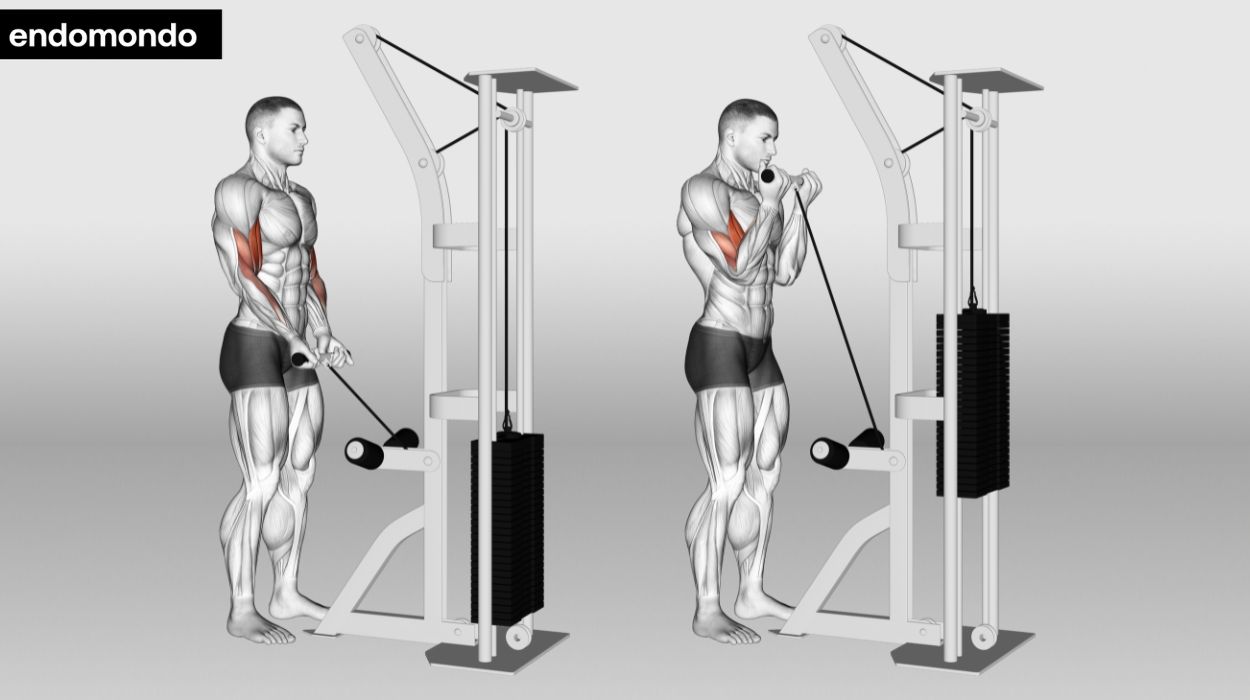
How to do:
- Put a bar attachment onto the cable machine and bring it to the lowest setting.
- Grasp the bar attachment with an underhand grip, which is closer than hip-width apart, and then stand up.
- Stand up with the feet hip-shoulder width apart.
- Keep the upper arm and shoulder joint stable, breathe in, and begin to curl the bar attachment up.
- Breathe out and lower the bar attachment.
- Repeat the movement for the intended rep range.
Tips:
- Use a close grip attachment on the cable machine and maintain a stable stance with feet shoulder-width apart to ensure proper balance and stability.
- Keep your elbows close to your sides throughout the movement, focusing on isolating the biceps and minimizing momentum.
- Contract your biceps fully at the top of the movement and control the weight as you lower it back to the starting position for optimal muscle engagement.
Optimal Sets and Reps: 4 sets of 10-12 reps.
Single Arm Cable Curl
The single-arm cable curl variant allows you to focus on one arm at a time and squeeze at the top of the movement, which may activate the long head of the biceps even more.
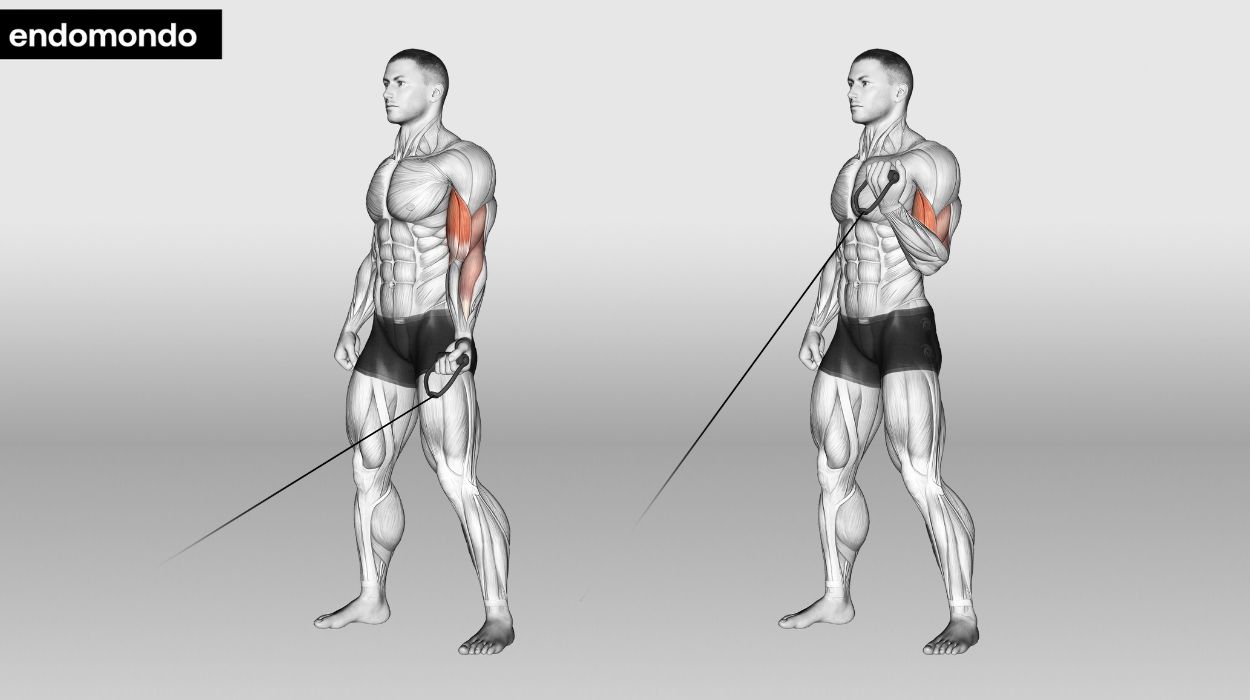
How to do:
- Put a single handle attachment onto the cable machine and bring it to the lowest setting.
- Grasp the single-handle attachment with an underhand grip.
- Stand up with the feet hip/shoulder width apart.
- Keep the upper arm and shoulder joint stable and pull behind the trunk of the body.
- Breathe in and begin to curl the single-arm attachment up to the shoulder position.
- At the top of the movement squeeze the biceps for more bicep activation.
- Breathe out and lower the single-hand attachment.
- Repeat the movement for the intended rep range.
Tips:
- Maintain a stable stance with feet shoulder-width apart and engage your core to prevent excessive twisting or swaying during the movement.
- Keep your elbow close to your side and your upper arm stationary, focusing on isolating the biceps and avoiding momentum.
- Contract your biceps fully at the top of the movement, squeezing for a brief pause before lowering the weight back down in a controlled manner.
Optimal Sets and Reps: 4 sets of 10-12 reps.
Benefits Of Bicep Long Head Exercises
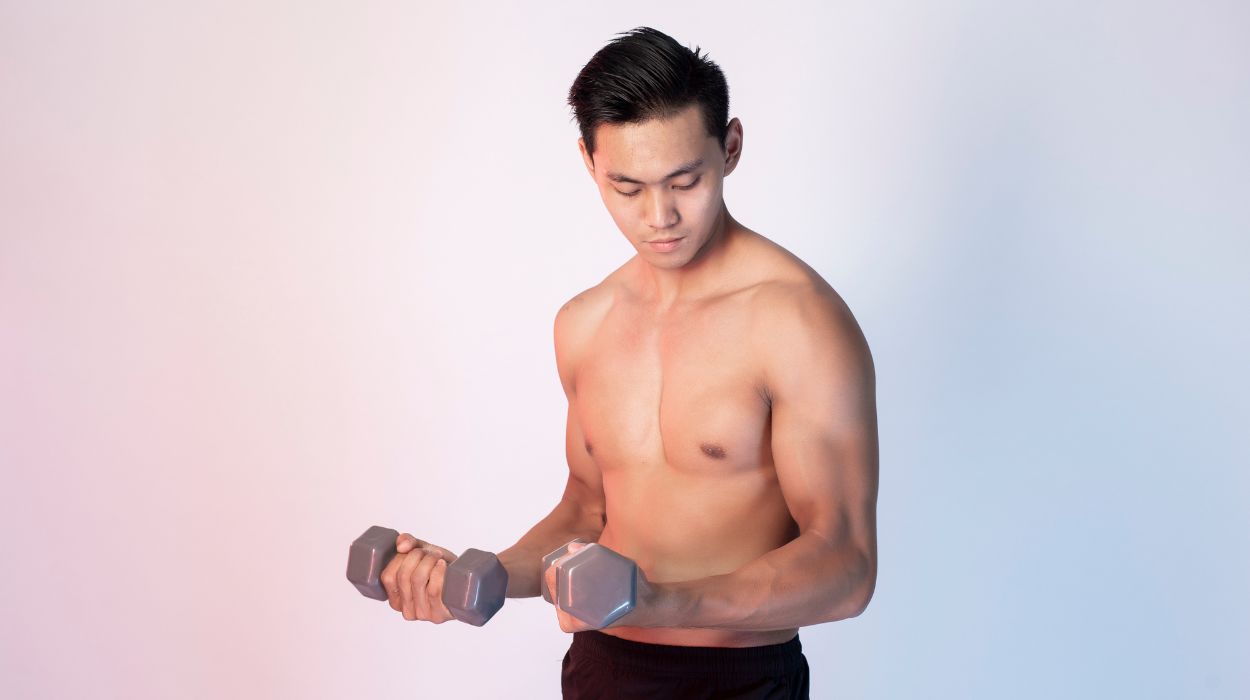
Complete The Bicep Development
We all want those boulder biceps, but it is important to develop all parts of the bicep.[2] As the name suggests, the biceps are made up of two muscles, which include the short head (inner part) and the long head (outer part).
To form the outer bicep peak, you must include long head-specific exercises. This may complete the bicep development. Furthermore, these exercises will make your biceps appear larger overall.
Build Bicep Strength
To maximize elbow flexion strength[3] (curling the lower arm) we must utilize exercises from different angles, which include the long head specific positions i.e., incline dumbbell curls and dumbbell hammer curls.
Remember, size and strength go hand in hand, so the goal is to make the long head bigger and stronger by using long exercises with moderate-heavy loads.
Develop Grip Strength
Gripping a dumbbell or an object, in general, will draw some grip strength from tapping into grip-specific and forearm muscles.
Bicep curls in long head-specific positioning may stimulate the grip strength if they are an addition to your current strength training routine, thereby further improving grip strength.
Prevent Injuries
Long head bicep exercises help build up bicep and shoulder strength and stability, which makes them less susceptible to strain and tear.
Tips For Doing Long Head Bicep Exercises
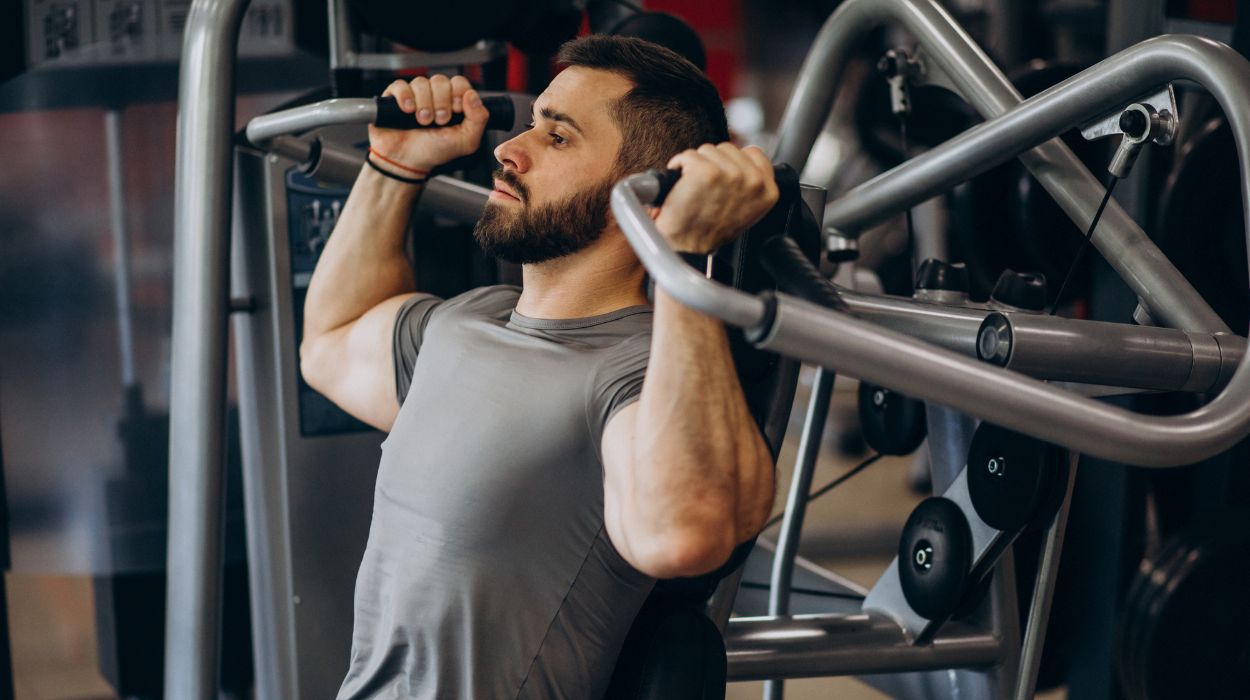
Pin The Shoulders Back
The long head of the biceps inserts into the shoulders and is activated when the shoulders are pinned and brought behind the body, this is because the bicep head is placed into a stretched and active position.
The idea is to target the long head of the bicep as much as possible, it is important to pin the shoulders/upper arms throughout any long head-specific movements.
Focus On Lower Arm Flexion (Bicep Curl)
To minimize the involvement of other areas of the shoulder, make sure that you use the lower arm and hinge at the elbow or any long head-specific bicep curl. Some lifters bring the weight up with the legs, back, and upper arms, which reduces bicep activation.
Optimize Breathing Techniques
At times breathing can be undervalued when it comes to lifting, but it can make all of the difference. Breathing can help stabilize the core and spine from becoming loaded, where the spine becomes curved and pressured in an unnatural and unsafe position. In turn, this could reduce the chances of injury.
Secondly, breathing ensures that oxygenated blood reaches the brain and muscles, which lowers the risk of fainting.
Observe Good Nutrition
The missing gap is nutrition. To optimize the appearance of the bicep long head, you must observe a diet that. We suggest starting the day with a healthy and wholesome breakfast. Then focus on not overeating and working your way to ~1g of protein per pound of body weight every day. Overall this will improve body composition and the appearance of the biceps.
Conclusion
All in all, if you want to maximize bicep development in terms of size and strength, you must include long head-specific exercises.
These exercises are built around the idea of putting the long head in a stretched position to make it more dominant and activated over other muscles and the head of the bicep.
By including long head-specific exercises you may improve grip strength and reduce bicep injury risk. Feel free to try one of our six long-head bicep recommendations.
Frequently Asked Questions
Any type of movement that stretches the shoulder and upper arms behind the body puts additional emphasis on the long head of the biceps i.e., incline curls and drag curls.
Lay on an inclined bench ~30-45 degrees and let the arms fall behind the body before curling.
For muscle and strength, we are generally looking at ~70-85% intensity for 6-12. So if you could lift 110 pounds for 1 rep this would be your 100% 1RM, and 70% of this would be 77 pounds, where you may get around 12 reps.
Resources
- Barakat, C., Barroso, R., Alvarez, M., Rauch, J., Miller, N., Bou-Sliman, A. and De, E.O. (2019). The Effects of Varying Glenohumeral Joint Angle on Acute Volume Load, Muscle Activation, Swelling, and Echo-Intensity on the Biceps Brachii in Resistance-Trained Individuals. Sports, [online] 7(9), pp.204–204. doi:https://doi.org/10.3390/sports7090204.
- Diplock, B., Hing, W. and Marks, D. (2023). The long head of biceps at the shoulder: a scoping review. BMC Musculoskeletal Disorders, [online] 24(1). doi:https://doi.org/10.1186/s12891-023-06346-5.
- Loenneke, J.P., Dankel, S.J., Bell, Z.W., Buckner, S.L., Mattocks, K.T., Jessee, M.B. and Abe, T. (2019). Is muscle growth a mechanism for increasing strength? Medical Hypotheses, [online] 125, pp.51–56. doi:https://doi.org/10.1016/j.mehy.2019.02.030.




